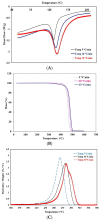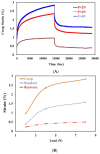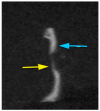Porous Polyethylene Coated with Functionalized Hydroxyapatite Particles as a Bone Reconstruction Material
- PMID: 29596358
- PMCID: PMC5951367
- DOI: 10.3390/ma11040521
Porous Polyethylene Coated with Functionalized Hydroxyapatite Particles as a Bone Reconstruction Material
Abstract
In this study, porous polyethylene scaffolds were examined as bone substitutes in vitro and in vivo in critical-sized calvarial bone defects in transgenic Sprague-Dawley rats. A microscopic examination revealed that the pores appeared to be interconnected across the material, making them suitable for cell growth. The creep recovery behavior of porous polyethylene at different loads indicated that the creep strain had two main portions. In both portions, strain increased with increased applied load and temperature. In terms of the thermographic behavior of the material, remarkable changes in melting temperature and heat fusion were revealed with increased the heating rates. The tensile strength results showed that the material was sensitive to the strain rate and that there was adequate mechanical strength to support cell growth. The in vitro cell culture results showed that human bone marrow mesenchymal stem cells attached to the porous polyethylene scaffold. Calcium sulfate-hydroxyapatite (CS-HA) coating of the scaffold not only improved attachment but also increased the proliferation of human bone marrow mesenchymal stem cells. In vivo, histological analysis showed that the study groups had active bone remodeling at the border of the defect. Bone regeneration at the border was also evident, which confirmed that the polyethylene acted as an osteoconductive bone graft. Furthermore, bone formation inside the pores of the coated polyethylene was also noted, which would enhance the process of osteointegration.
Keywords: hydroxyapatite; mesenchymal stem cells; porous polyethylene.
Conflict of interest statement
The authors declare that there are no conflicts of interest or state among all the contributors.
Figures














Similar articles
-
PEGylated poly(glycerol sebacate)-modified calcium phosphate scaffolds with desirable mechanical behavior and enhanced osteogenic capacity.Acta Biomater. 2016 Oct 15;44:110-24. doi: 10.1016/j.actbio.2016.08.023. Epub 2016 Aug 17. Acta Biomater. 2016. PMID: 27544808
-
Biomimetic porous Mg with tunable mechanical properties and biodegradation rates for bone regeneration.Acta Biomater. 2019 Jan 15;84:453-467. doi: 10.1016/j.actbio.2018.11.045. Epub 2018 Nov 27. Acta Biomater. 2019. PMID: 30500444
-
Anti-infective efficacy, cytocompatibility and biocompatibility of a 3D-printed osteoconductive composite scaffold functionalized with quaternized chitosan.Acta Biomater. 2016 Dec;46:112-128. doi: 10.1016/j.actbio.2016.09.035. Epub 2016 Sep 26. Acta Biomater. 2016. PMID: 27686039
-
Zero-order controlled release of BMP2-derived peptide P24 from the chitosan scaffold by chemical grafting modification technique for promotion of osteogenesis in vitro and enhancement of bone repair in vivo.Theranostics. 2017 Feb 27;7(5):1072-1087. doi: 10.7150/thno.18193. eCollection 2017. Theranostics. 2017. PMID: 28435449 Free PMC article.
-
Bone tissue engineering with porous hydroxyapatite ceramics.J Artif Organs. 2005;8(3):131-6. doi: 10.1007/s10047-005-0292-1. J Artif Organs. 2005. PMID: 16235028 Review.
Cited by
-
Synthetic materials in craniofacial regenerative medicine: A comprehensive overview.Front Bioeng Biotechnol. 2022 Nov 9;10:987195. doi: 10.3389/fbioe.2022.987195. eCollection 2022. Front Bioeng Biotechnol. 2022. PMID: 36440445 Free PMC article. Review.
-
Evaluation of tissue ingrowth and reaction of a porous polyethylene block as an onlay bone graft in rabbit posterior mandible.J Periodontal Implant Sci. 2020 Mar 19;50(2):106-120. doi: 10.5051/jpis.2020.50.2.106. eCollection 2020 Apr. J Periodontal Implant Sci. 2020. PMID: 32395389 Free PMC article.
-
A novel, self-assembled artificial cartilage-hydroxyapatite conjugate for combined articular cartilage and subchondral bone repair: histopathological analysis of cartilage tissue engineering in rat knee joints.Int J Nanomedicine. 2019 Feb 19;14:1283-1298. doi: 10.2147/IJN.S193963. eCollection 2019. Int J Nanomedicine. 2019. PMID: 30863061 Free PMC article.
-
Review of Plastic Surgery Biomaterials and Current Progress in Their 3D Manufacturing Technology.Materials (Basel). 2020 Sep 16;13(18):4108. doi: 10.3390/ma13184108. Materials (Basel). 2020. PMID: 32947925 Free PMC article. Review.
-
Characterization of Biological Properties of Dental Pulp Stem Cells Grown on an Electrospun Poly(l-lactide-co-caprolactone) Scaffold.Materials (Basel). 2022 Mar 3;15(5):1900. doi: 10.3390/ma15051900. Materials (Basel). 2022. PMID: 35269131 Free PMC article.
References
-
- Behnaz B., Payam Z., Mohammad O.O., Farid K., Hamideh F., Sohrabi-Jahromi S., Zarrintaj Z. Tissue engineering; strategies, tissues, and biomaterials. Biotechnol. Genet. Eng. Rev. 2017;33:144–172. - PubMed
-
- Schlickewei W., Schlickewei S. The use of bone substitutes in the treatment of bone defects—The clinical view and history. Macromol. Symp. 2007;253:10–23. doi: 10.1002/masy.200750702. - DOI
-
- Stevens M.M. Biomaterials for bone tissue engineering. Mater. Today. 2008;11:18–25. doi: 10.1016/S1369-7021(08)70086-5. - DOI
LinkOut - more resources
Full Text Sources
Other Literature Sources

